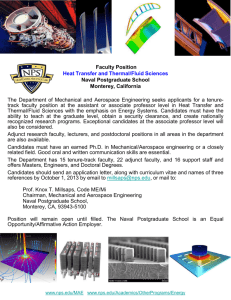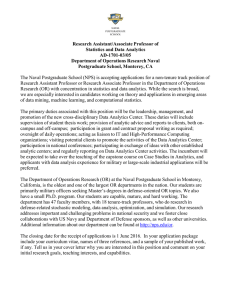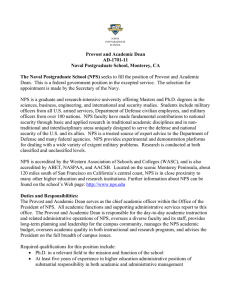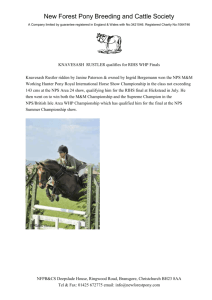NPS - Making a Difference in STEM Education
advertisement
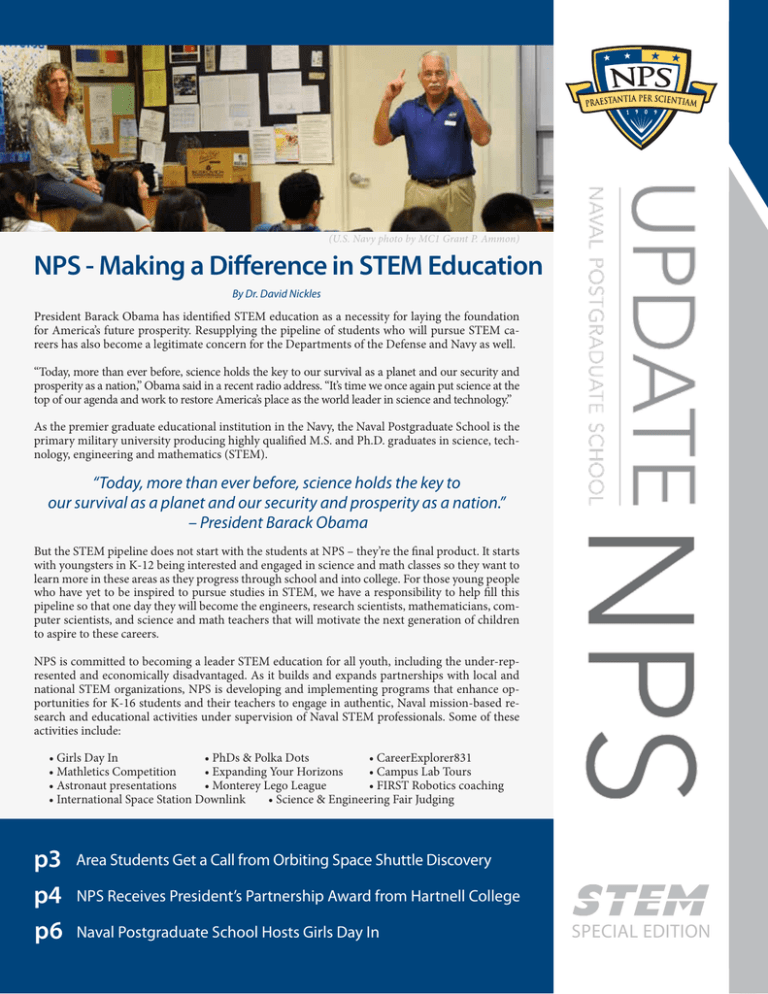
(U.S. Navy photo by MC1 Grant P. Ammon) NPS - Making a Difference in STEM Education By Dr. David Nickles President Barack Obama has identified STEM education as a necessity for laying the foundation for America’s future prosperity. Resupplying the pipeline of students who will pursue STEM careers has also become a legitimate concern for the Departments of the Defense and Navy as well. “Today, more than ever before, science holds the key to our survival as a planet and our security and prosperity as a nation,” Obama said in a recent radio address. “It’s time we once again put science at the top of our agenda and work to restore America’s place as the world leader in science and technology.” As the premier graduate educational institution in the Navy, the Naval Postgraduate School is the primary military university producing highly qualified M.S. and Ph.D. graduates in science, technology, engineering and mathematics (STEM). “Today, more than ever before, science holds the key to our survival as a planet and our security and prosperity as a nation.” – President Barack Obama But the STEM pipeline does not start with the students at NPS – they’re the final product. It starts with youngsters in K-12 being interested and engaged in science and math classes so they want to learn more in these areas as they progress through school and into college. For those young people who have yet to be inspired to pursue studies in STEM, we have a responsibility to help fill this pipeline so that one day they will become the engineers, research scientists, mathematicians, computer scientists, and science and math teachers that will motivate the next generation of children to aspire to these careers. NPS is committed to becoming a leader STEM education for all youth, including the under-represented and economically disadvantaged. As it builds and expands partnerships with local and national STEM organizations, NPS is developing and implementing programs that enhance opportunities for K-16 students and their teachers to engage in authentic, Naval mission-based research and educational activities under supervision of Naval STEM professionals. Some of these activities include: • Girls Day In • PhDs & Polka Dots • CareerExplorer831 • Mathletics Competition • Expanding Your Horizons • Campus Lab Tours • Astronaut presentations • Monterey Lego League • FIRST Robotics coaching • International Space Station Downlink • Science & Engineering Fair Judging p3 p4 p6 Area Students Get a Call from Orbiting Space Shuttle Discovery NPS Receives President’s Partnership Award from Hartnell College Naval Postgraduate School Hosts Girls Day In SPECIAL EDITION Walt Havenstein, left, talks to FIRST Founder Dean Kamen before the opening ceremonies of the Washington, D.C. Regional FIRST Robotics Competition, Mar. 23 Havenstein serves as the CEO of SAIC, as well as the Chairman of the Board of Directors for FIRST. SAIC CEO and NPS Alumnus Brings Passion to Promoting STEM Fields to America’s Youth By Amanda D. Stein The Naval Postgraduate School (NPS) has long been vested in the STEM – or Science, Technology, Engineering and Mathematics – disciplines, not only for the thousands of military officers and DoD civilians who have crossed the stage in King Auditorium, but also for the dozens of young adults interning across campus at any given time. NPS alumni see first-hand the value of education in these technical arenas. For graduate Walt Havenstein, however, promoting the sciences is both his day job, and his free time. Havenstein is the Chief Executive Officer of Science Applications International Corporation (SAIC), which uses scientific, engineering and technology applications to solve real-world problems. He also serves as the Chairman of the Board of Directors of For Inspiration and Recognition of Science and Technology (FIRST), a not-for-profit organization founded to inspire young people’s interest and participation in science and technology. During his 12 years serving on active duty in the Marine Corps, Havenstein received his bachelor’s degree in aerospace engineering from the U.S. Naval Academy, and went on to get his master’s degree in electrical engineering from NPS in 1977. He transitioned to the Reserves in 1983 and began his work as a civilian in the defense industry. With national security being one of their key areas of focus, SAIC works frequently with the Department of Defense (DoD), the Department of Homeland Security (DHS) and other departments of the U.S. government. But their work also extends to a wide range of global problems, from public health issues to protecting critical infrastructure, all of which heavily rely upon the STEM fields. “Many of the solutions to national problems, and ways to improve our lifestyles here in the United States and around the world, come from science, technology, engineering and mathematics,” explained Havenstein. “Virtually all of our standards of living are based on invention and innovation that start with a fundamental understanding of science, the application of science through engineering, and inevitably, mathematics. Whether it’s the house you live in, the water you drink, the energy you use, or the healthcare that we take for granted, all are based on solutions or inventions that came from the application of basic science and mathematics.” Naturally, as the STEM workforce ages, the need for fresh young faces is constant. For the past 15 years, Havenstein has worked closely with FIRST to help inspire new generations of scientists and engineers through programs and competitions for young people around the world. FIRST provides mentor-based STEM programs and support to kids K-12, emphasizing the value of their achievements and providing opportunities for college scholarships. Havenstein has a noticeable passion for FIRST, noting that there should be an emphasis on the STEM fields in much the same way sports are encouraged at an early age. “If you are going to inspire young people to want to deal with the rigors of these academic disciplines, you have to capture their imaginations relatively early in life, and reinforce that imagination by making what I will call heroes out of scientists and engineers, the way we do out of athletes.” “Update NPS” is a monthly publication for students, faculty and staff of the Naval Postgraduate School produced by the Office of Institutional Advancement. For additional copies, comments, or to suggest story ideas, contact the editorial staff at update@nps.edu. Area Students Get a Call from Orbiting Space Shuttle Discovery successes By Dale Kuska More than 1,000 students, parents and members of the NPS community packed King Auditorium Saturday morning where they received a call from the Space Shuttle Discovery orbiting more than 200 miles into space — part of the NPS Centennial’s Education Downlink STS-131, Teaching from Space event. Thanks to the diligent efforts of NPS’ Centennial Headquarters and faculty astronauts, NPS was approved as one of two locations to host an educational downlink from the Space Shuttle while on its 13-day mission to the International Space Station. Shuttle Commander and NPS graduate, Navy Capt. Alan “Dex” Poindexter, along with Mission Specialist Dottie MetcalfLindenburger and Pilot Air Force Col. Jim Dutton engaged approximately 700 students from across the Peninsula in a lively discussion about their mission and the realities of weightlessness in space, while select students were also allowed to ask questions of their own. Students were immediately introduced to the visually-stunning impact of weightlessness as Metcalf-Lindenburger’s hair floated wildly in all directions while Poindexter “I’ve never been the type of girl who could just sit and play with Barbies or play video games. I have to be engaged,” says NPS intern Morgan Juran, whose dream as a little girl was to become a Marine “because they’re pretty tough and they don’t take no for an answer!” Morgan lifelong aspiration to join one of the services was derailed because of her prosthesis, but that hasn’t stopped her from working to achieve another of her dreams, becoming a biomechanical engineer. was suspended upside down. But in spite of the fun, and great questions from the students such as whether or not the crew had seen any aliens, the downlink is really about education and opportunity. “NASA’s very charter includes educational outreach as one of its important activities,” said Newman, a member of four space shuttle flights from 1993-2002. “With its goals of exploration and discovery, it has been recognized since NASA’s inception that the space program provides a unique opportunity to motivate young people. Science, math, and engineering can be difficult subjects, and we as a country need to offer many reasons why kids should study hard in school. I think the NASAs human spaceflight program its science and robotics programs are some good reasons … And, in the end, it is rocket science.” NPS boasts more astronaut graduates than any other graduate-level institution in the world. In its role as a university that is educating tomorrow’s cadre of space travelers now, according to Director of Alumni Relations and Centennial Planning Kari Miglaw, where better to expose the next generation’s pool of potential astronauts than the Naval Postgraduate School. “One of the reasons I want to be an engineer is because I’m really curious.” As a high school student Morgan used her personal experience and curiosity about biomechanical engineering to design the award winning Science Fair project “Prosthetics and myoelectric impulses in the human arm.” Since high school she has recognized how different and rewarding doing “real” scientific research can be. “In my science fair project I had a generally good idea what my answer was before I started, but this (research) is all stuff that takes months and you don’t already know what the outcome will be.” Determining the full capacity of different computer programs NPS researchers and students are using, Morgan learned patience as she spent a lot of her internship watching graphs form and interpreting the results. “It isn’t all that exciting, but when you think something will give a completely flat graph, and you get a graph that has an enormous spike, you’re like ‘Aahhh, that was unexpected!’” Morgan’s career path, once disrupted, is now re-crystallizing. “I want to do prosthetics and still want to advance defense technology, so I really hope to work for the NSA, because that’s the highest level you can get serving the country without going military. Senior NPS staff are presented with the Hartnell President’s Partnership Award. NPS Receives President’s Partnership Award from Hartnell College By Amanda D. Stein What began as an informal mentorship by Naval Postgraduate School (NPS) faculty to foster an interest in science among community college students has now evolved into an award‐winning, campus‐wide internship program. NPS was honored at the 2008 Hartnell College Foundation Party in the Library with the President’s Partnership of Excellence Award, which recognizes an organization that has made significant contributions and impacts to the school’s program and institutional advancement. NPS received the award for its “exemplary partnership and support of the Hartnell College science program.” Phoebe Helm, President of Hartnell College, commended NPS for offering community college students the opportunity to work on world‐class research projects. “Giving this kind of high level exposure to sophisticated, rigorous study through mentoring relationships is turning Hartnell’s math and science students into serious high‐achieving, engineers, mathematicians, computer scientists and rocket scientists,”she explained. “Largely because of your [NPS] support, Hartnell is becoming known as a magnet college for math and sciences.” Joe Welch, an NPS Lecturer for Information Sciences and a Computer Science Instructor at Hartnell College, first began meeting with students from neighboring Salinas, Calif., to encourage greater awareness of educational paths involved with math and science. In 2006, he and NPS Prof. Craig Martell partnered with Hartnell Instructors Pimol Moth and Shannon McCann to provide four students with summer internships at the NPS robotics lab. The following summer, NPS Prof. Chris Brophy also joined the partnership to provide Hartnell students an opportunity to intern at the school’s rocket lab. Building upon the strong relationships Welch and Martell have developed with Hartnell, the NPS Cebrowski Institute for Innovation and Information Superiority recently began formalizing the internship process. Sue Higgins, Deputy Director for the Cebrowski Institute, and Program Manager Alison Kerr organized a pilot program they described as academic “speed‐dating,” a match‐making event where more than a dozen Hartnell students and NPS faculty met to discuss possible internship opportunities. “What we’re trying to do is find the right fit, whether a student is most interested in computer science, in one of the engineering fields, space systems or operations research. We’re trying to broaden their experience but also give our faculty an opportunity to have some very talented undergraduate students work with them across the summers as interns,” said Higgins. NPS Provides Local College Student Research Experience Ever since he was a child, 25‐year‐ old Rodrigo Sanchez knew he wanted to be an engineer. But as a first generation college student with limited financial support, Sanchez didn’t know how he was going to find the resources he would need to pursue his lifelong dream. But while studying at Hartnell Community College in Salinas, Calif. two years ago, Sanchez found his answer. Rodrigo Sanchez Still in its development stage, Sanchez applied to Hartnell’s STEM internship program, which would place him in a research internship at a partner institution. In 2008, Sanchez began his first summer internship at NPS, where he spent several weeks working in the school’s Marine Propulsion laboratory. Sanchez returned to NPS the following year, and spent his entire summer working in the Control and Optimization Laboratories on the development of a small‐scale autonomous Unmanned Ground Vehicle. Sanchez recently graduated from California Polytechnic State University in San Luis Obispo. NPS Hosts Young Scientists, Engineers for Hands-on Internships By Amanda D. Stein NPS reaches beyond the gates surrounding the campus to connect with students in the science, technology, engineering and mathematics (STEM) fields. The various schools, departments and Institutes on campus host dozens of high school, undergraduate and graduate students from schools locally and across the country. The internships foster a sense of continuous learning and networking while encouraging budding scientists and engineers to pursue careers within the Department of Defense. “These internships are important for the students because it gives them the opportunity to do hands‐on laboratory work on focused research projects of national interest,” noted Jim Newman, a professor in the Space Systems Academic Group (SSAG). “This kind of project‐ based learning and experience set the basis for my own career, and I feel that it really creates a very powerful environment for learning.” During the summer, the NPS campus is like a school within a school, bringing in dozens of interns to work alongside experienced faculty, researchers and graduate students on various projects. This summer, more than 180 interns, both new and returning, joined the NPS community. Funding for the interns comes from various grants either through NPS or the college where the students come from. In the fall, most of the students will return to their studies, while some will continue to work throughout the year. The Space Systems Academic Group currently has 10 high school, undergraduate and graduate level students from Salinas, San Luis Obispo, Montana, Michigan, Tennessee and the Monterey Peninsula, getting hands‐on lab experience alongside NPS students and faculty. Under the direction of Professor Newman and Professor Rudy Panholzer, the interns are paired up throughout the group with different researchers and projects that fit their interests or funding. Newman worked as an astronaut for NASA for almost 20 years before taking a teaching position in the Space Systems Academic Group at NPS. Monterey Space Camp Gets First-Hand View of Work, Life on the ISS By Javier Chagoya NPS visiting Professor and NASA Astronaut John Phillips talks to youngsters about living and working on the International Space Station (ISS) as part of a Lyceum of Monterey County Space Camp program. Twenty-five students from local high schools participated in the week-long forum on space-related activities which concluded with the trip to NPS. Hosted by the university’s Graduate School of Engineering and Applied Sciences, the tour offered space camp participants an opportunity to learn about working in space, current satellite technologies, rocket fuels and other space systems from the experts who teach tomorrow’s astronauts all about them. Selected for Astronaut candidate training in 1996, Phillips has since made three trips to the International Space Station, totaling 203 days in space. His most recent trip to the final frontier was with STS-119, a 13-day mission aboard the Space Shuttle Discovery in March of 2009. successes Jeremy, a June 2010 York High School graduate, interned part-time at the Naval Postgraduate School (NPS) for nearly a year. Through his experience, Jeremy learned a lot about electronics and had the opportunity to apply that knowledge in a practical way, including designing a programming interface that significantly improved a particular data collection process. Moreover, he gained a greater appreciation for what he was learning in his high school classes, noting that, “All the stuff we learned in calculus and various math classes actually makes sense here when you can apply it.” Being exposed to the practical aspects of research and development at the NPS opened Jeremy’s eyes to how the real world of research is different than he had envisioned it. “Before this [internship], I didn’t really know what the term ‘research’ meant. I thought ‘Oh, it’s theoretical physics, and I’m not really interested in that.’ But [research] definitely has more opportunity for hands-on experience than I thought.” Having gained a new appreciation for applied research from his experiences at NPS, Jeremy’s next steps toward a STEM career began in fall 2010 when he started college as an electrical engineering major at UC Berkeley. Unlike many other freshmen, Jeremy brought a practical, authentic understanding of the importance of his engineering studies. Have a question about STEM related activities at NPS? Contact Dr. David Nickles, Director of Research Communications and Outreach at danickle@nps.edu Naval Postgraduate School Hosts Girls Day In By MC1 Grant P. Ammon More than 50 young women from Monterey-area high schools and middle schools descended upon the Naval Postgraduate School campus, Mar. 11, as part of the Girls Day In pilot program. Girls Day In is a new K-12 outreach program that aims to introduce science and technology disciplines to children in the local Monterey community by providing opportunities for female students from local schools to explore the fields of science, technology, engineering and math (STEM). “Don’t be afraid to try new things,” encouraged Sherman during her opening remarks. “This profession is hard, but I believe failures are almost as important as the successes.” Sherman shared her experiences working as an engineer and researcher with the girls and chaperones in attendance during her kick-off speech. She vividly detailed her adventurous career as an engineer studying ice caps in Antarctica, mapping the ocean floor inside the submersible capsule “Alvin” and piloting remotely-operated vehicles. Sherman also shared her feelings on the study of math and science that she had early in her scholastic endeavors. “I had some tough math and science teachers in high school. In my first year of college, I took an astronomy class and was relieved that it would be my last exposure to science and math,” Sherman noted. “Down the road I took another math course and the teacher was great. I really started enjoying my math and science courses. I realized math was fun.” Dr. Alana Sherman, of the Monterey Bay Aquarium Research Institute (MBARI) delivers a speech during Girls Day In. (U.S. Navy photo by MC1 Grant P. Ammon) The girls were also taken on an escorted tour of the university campus by volunteers from the Monterey Sea Service Leadership Association (SSLA) and were afforded the opportunity to see first-hand the world-class research laboratories. The SSLA volunteers saw the afternoon as a chance to provide guidance and mentorship to a younger population of girls that may be interested in pursuing careers in the STEM fields. During the day-long event, the girls were exposed to a variety of presentations and activities, which included opening remarks by university president Dan Oliver and a keynote address by Dr. Alana Sherman, pictured above, of the Monterey Bay Aquarium Research Institute (MBARI), in addition to the opportunity to build, program and operate robots under the tutelage of NPS professor Timothy Chung. “A primary function of our organization is the mentorship of fellow women serving in the sea services. Girls Day In was an opportunity to continue that mentorship and outreach,” said Navy Lt. Heather Hornick, a meteorology student at NPS and member of the SSLA. “As soon as we heard about the program we asked how SSLA could help. Taking the time to volunteer at this event gave us the chance to work with young girls and show them the opportunities that are possible in the science and engineering career fields.” University Welcomes Top County Students for Annual Mathletics By MC1 Grant P. Ammon The Naval Postgraduate School opened its doors to hundreds of county math whizzes when the university hosted the 43rd Annual Monterey County Mathletics Competition, May 14. Mathletics is an annual contest established to promote excellence in mathematics, and to recognize the achievements of local students and their schools. Coordinated by the Monterey County Office of Education, the event is made possible by donations and volunteers from the primary sponsoring schools, California State University Monterey Bay (CSUMB) and NPS. The contest, open to Monterey County students from grades 5-12, brought more than 350 youth onto campus as each school’s team is allowed up to three students per test. Dr. David Nickles, NPS’ Director of Research Communications and Outreach, played a lead role in bringing the event to NPS, and was already well versed in the competition. “I’ve been a big fan of Mathletics for 12 years dating back to my days as Science/Math Coordinator for the Monterey County Office of Education,” he said. “At that time, we held Mathletics at Hartnell College and it was evident from the enthusiasm of the kids that participated back then, as well as today, that for them, math was fun!” Nickles added that recognizing the fun in math is a primary goal of the competition, but the value in the annual event is far than just fun and games. “Mathematics courses, especially algebra, are generally considered gatekeepers to kids taking advanced science in high school, and in their later pursuit of science, engineering or technology careers while in college,” Nickles explained. “Mathletics is a comprehensive mathematics competition designed to promote excellence in math and ... becoming ‘Mathletes’ encourages children to practice mathematics so they will not only enjoy, and not fear, learning to abstract, but so they will compete better in school.” Any Day at NPS ... successes e are shown with ool and Hartnell Colleg Naval Postgraduate Sch the ronautics and m Ae fro of y te ult titu fac Ins Region VI American A team of students and ual ann d on sec the arting to ion. their rockets before dep cket Launch Competit Young Professional Ro ) IAA (A tics nau tro As NPS Assistant Professor and C4I Chair Rachel Goshorn highlights some of the sensors on board one of many autonomous vehicles in the university’s UAV/AUV Robotics Lab. About 25 children and parent chaperones from the First LEGO League of Monterey toured the lab in November. NPS Associate Professor of Physics Bruce Denardo demonstrates the effects of liquid nitrogen on an acoustic device during a visit by students of the Monterey Academy of Oceanographic Science (MAOS). A group of approximately 60 high school students toured NPS, participating in and observing demonstrations from throughout the school. tion during the An NPS student shows off his crea val. Faculty festi s” Rose the in ots university’s “Rob came to the and students from across campus ial event to mark university’s rose garden for a spec -sponsored the initial stand-up of the SECNAV anned Systems Unm and otics Rob Consortium for SER. Education and Research, or CRU NPS spo nsored B reak able for c hildren in fast for your Bra in tutori grades K Whitney ng p - 12 in th (seated) e Montere rogram is availis a resea School’s rch assoc y Bay Are Operatio iate at th a. Laura ns Resea e Naval P rch depa ost rtment (S EED Cen graduate ter). Unlike many teenagers who enjoy a respite from challenging study and complex thinking before tackling their senior year of high school, Abigail (Abby) Hoffman spent her summer as an intern learning to run a Scanning Electron Microscope (SEM). Never having seen a SEM (she looked it up on Wikipedia before her first visit to the lab), Abby went through a week of training before starting to take high resolution, very high magnification pictures for researchers like Distinguished Professor Nancy Haegel in the Physics Department at NPS. She described the SEM as a sophisticated camera that “uses electrons instead of light for particles are too small to be seen by laser light, which is really cool. And now that I’ve been on it for a couple weeks, anyone in the physics department, if they have samples that they need high resolution pictures of, then they come to me and I know how to prepare them. I’m getting really good pictures.” As a senior who will take Physics, AP Chem, AP Calc, AP English, economics, chorus and orchestra at Stevenson HS this fall, Abby had a typical view of high school before coming to NPS. “I went through school up until last year thinking if I’d been taught the information I’ll do well on the test. As long as I’ve been taught the information, then I know what to do.” Now, though, Abby has a new perspective on learning and plans to put her experiences at NPS to good use. “Coming here, it’s an entirely different process. One of the things I think has really influenced me is being able to take on projects and preparing yourself for them. It’s really exhilarating when someone says ‘Oh, I would like this fixed’ or ‘I would like to know if we can be able to do this’ and then it’s about doing the research and testing things out; more of an independent way of learning, which I really like. I think that’s definitely going to change how I go through my classes next year.” Upcoming Events at NPS Expanding Your Horizons “All Shades of Navy- Introducing Young Women to Naval Careers” is designed to introduce middle school girls to non-traditional Navy careers such as nuclear engineering, computer science, oceanography, and cryptology. Expanding Your Horizons National office will work with the Office of Naval Research to bring a new EYH conference to the Naval Postgraduate School in Monterey, California, this Fall. The Monterey conference at NPS will be open to young women in grades 5-11. Contact Dr. David Nickles at NPS for information. danickle@nps.edu Have a question about STEM related activities at NPS? Contact Dr. David Nickles, Director of Research Communications and Outreach at danickle@nps.edu Stay Connected. Stay Informed. Facebook facebook.com/NPSmonterey Twitter twitter.com/NPS_monterey Video Portal www.nps.edu/video/portal NPS News Center www.NPS.edu/news

